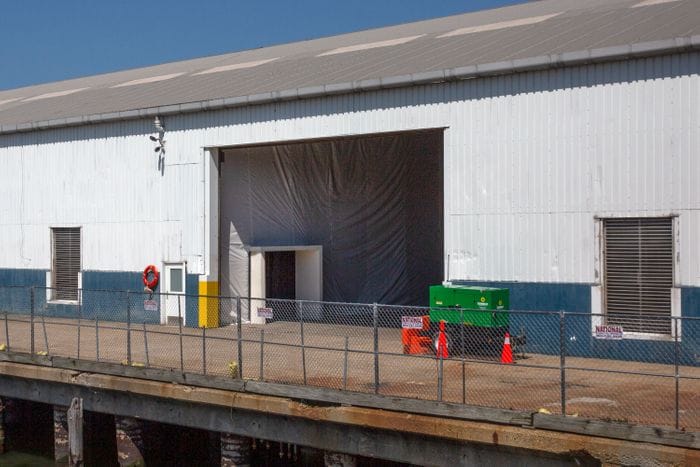Brooklyn Field Hospital Shuts After $21 Million Construction – And Zero Patients


By Yoav Gonen, Originally published in THE CITY.
A nearly $21 million field hospital green-lit by the de Blasio administration when coronavirus threatened to overrun local hospitals has opened and shuttered without treating a single patient, officials confirmed to THE CITY.
Mayor Bill de Blasio announced plans on March 31 to transform the temporarily idle Brooklyn Cruise Terminal in Red Hook into a 670-bed makeshift medical site.
That same day, he launched a smaller transformation of the Billie Jean King Tennis Center in Flushing into a 350-bed overflow facility — at a time when more than 8,400 patients were being treated in local hospitals for presumed or confirmed COVID-19.
The tennis center, designed as a release valve for the beleaguered, city-run Elmhurst Hospital in Queens, accepted its first patients April 11.

The next day, hospital bed utilization across the city hit its crisis peak of 12,184 — including more than 3,100 patients in critical care, state data shows.
But since April 12, hospital occupancy has dropped steadily — staving off predictive scenarios that could have seen medical centers at least triple their number of beds from 20,000 to 60,000.
Disasters a Specialty
Earlier this month, the makeshift hospital at the tennis center closed after taking in 79 patients, according to City Hall officials. It cost $19.8 million to construct and revert back, the officials said.
The lower-profile Red Hook terminal hospital was slated to open in mid-April but wasn’t ready for service until May 4. By then, citywide hospital utilization had already fallen by half its April 12 highpoint, to about 6,000 patients.
City officials say the $20.8 million site, constructed by Texas-based contractor SLSCO under a no-bid emergency contract, is now being demobilized after seeing no medical activity.
They expect the Federal Emergency Management Agency to pick up the costs for both of the temporary hospitals — which include an additional $2 million paid out to a second firm for construction management.
“As part of our hospital surge, we expanded capacity at a breakneck speed, ensuring our hospital infrastructure would be prepared to handle the very worst. We did so only with a single-minded focus: saving lives,” said Avery Cohen, a City Hall spokesperson.
“Over the past few months, social distancing, face coverings, and other precautionary measures have flattened the curve drastically, and we remain squarely focused on taking that progress even further,” Cohen added.
City officials did not respond to questions about which predictive models they relied on to come up with hospital bed targets under a worst-case scenario. On April 1, de Blasio said the city could need as many as 65,000 hospital beds and 20,000 critical care beds by May 1.
Asked on April 15 whether a decline in hospital occupancy would change those targets, de Blasio said he wanted to play it safe: “We do not know where this disease is going. It is the great unknown.”

SLSCO, which also built the Billie Jean King field hospital, has garnered hundreds of millions of dollars in government disaster contracts across the country — including in the aftermath of Superstorm Sandy for the city’s Build It Back program.
More recently, the firm landed more than $1 billion in work on President Donald Trump’s border wall project.
In recent years, the firm has been lobbying New York city and state officials on government contracts. SLSCO paid its lobbyists a total of $15,000 in March and April to target agencies involved in the COVID response — including the city’s Office of Emergency Management, according to state filings.
Reached for comment, company marketing director Elizabeth Rogers-Alvarado said in a statement: “SLS is extremely proud of our efforts to help NYC to be fully prepared to handle the estimated COVID positive patient load, and we stand ready to assist in the future if needed.”
Little-Used ‘Comfort’
Two field hospitals that state officials managed to secure in a hurry saw relatively limited but more significant use before being sidelined in late April and early May.
The USNS Comfort, a hospital ship operated by the U.S. Navy that arrived following Gov. Andrew Cuomo’s pleas for federal assistance, treated 182 patients during its nearly four weeks docked at Pier 90 in midtown Manhattan, according to ABC 7 news.

The nearby Javits Center, normally used to host massive conventions, treated nearly 1,100 patients before going idle at the beginning of this month, according to the New York Post.
The federal Army Corps of Engineers also spent more than $350 million for field hospitals in the New York City region that had been sought by Cuomo but were never utilized — including $136 million for a facility at Stony Brook on Long Island, according to the Associated Press.
State officials said their efforts to build temporary hospitals were based on models that predicted New York’s hospital bed capacity would need to more than double, from about 53,000 to 110,000.
The consulted models included those developed by the Institute for Health Metrics and Evaluation, the consulting firm McKinsey & Co, Columbia University, the federal Centers for Disease Control and Prevention and the White House Coronavirus Task Force, according to state officials.
They credited social distancing measures implemented in mid-March for helping to avert the more dire predictions.




